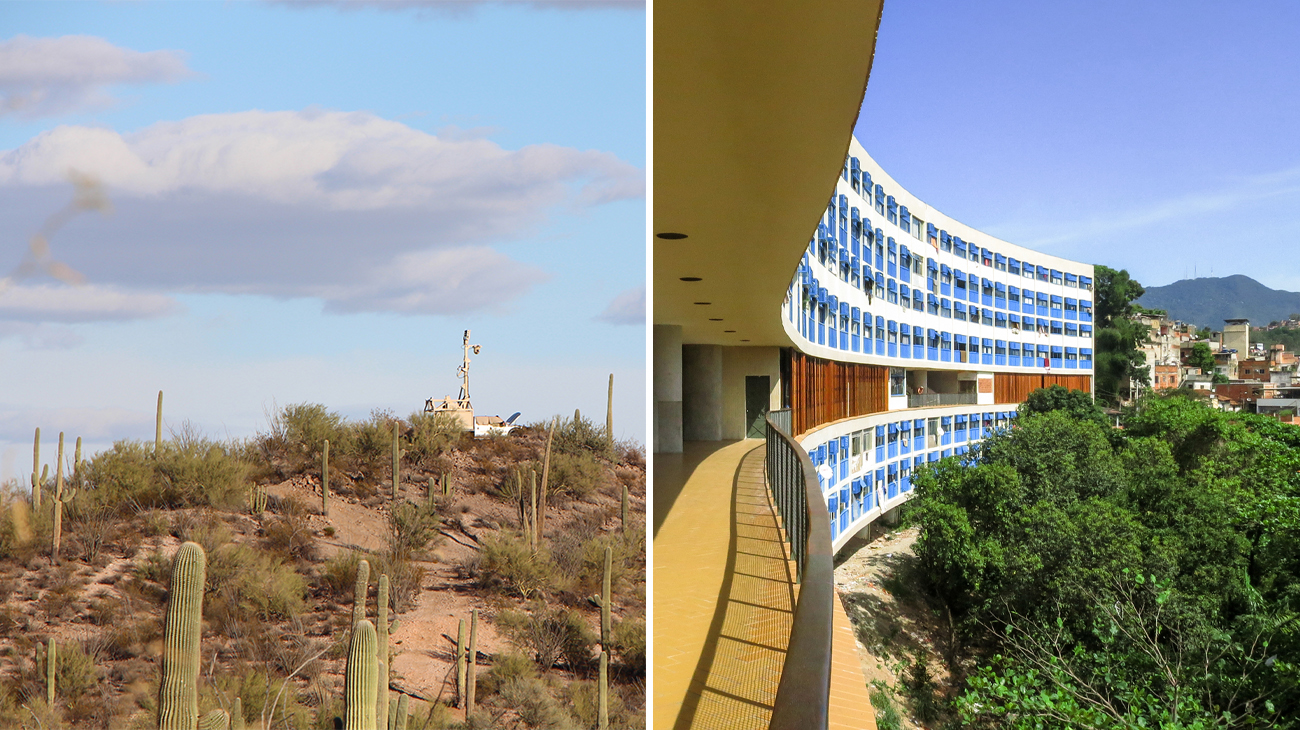A serpentine science
Bryan Maddock writes about the work of Brazilian architect Affonso Eduardo Reidy.
[L] Border between Sonora, Mexico, and the Tohono O’odham reservation near the Organ Pipe Cactus National Monument in Arizona. Credit: Caitlin Blanchfield and Nina Valerie Kolowratnik. View of Pedregulho, Block A, 2015. Credit: Alejandro Stein.
The Deborah J. Norden Fund, a program of The Architectural League of New York, was established in 1995 in memory of architect and arts administrator Deborah Norden. The competition awards up to $5,000 annually in travel grants to students and recent graduates in the fields of architecture, architectural history, and urban studies.
In 2016, the Architectural League awarded two grants: one to Bryan Maddock for “A Serpentine Science: Affonso Eduardo Reidy’s Housing Pair,” and another to Caitlin Blanchfield and Nina Kolowratnik for “Deserted Border Lands: Mapping Surveillance along the Tohono O’odham Nation.”
In search of a socially responsive and environmentally sensitive housing typology, Bryan Maddock traveled to Rio de Janeiro to retrace the legacy of architect Affonso Eduardo Reidy. Reidy’s work took the form of “serpentine” social housing blocks that integrated with the mountainous local topography and sought to “elevate the working class both physically and symbolically.” Tragically, Reidy died at the age of 55, and his work, both built and rendered, did not fare well in the authoritarian state that developed after his death. Many of the architect’s original documents were destroyed and his buildings fell into disrepair. Maddock conducted comprehensive surveys of the landscape where Reidy’s buildings are still extant in hopes of reconstructing an online visual archive of this work through drawings, video, and text. Maddock hopes to illuminate how Reidy’s work “serves as proof that architecture can operate as a fantastic offense for the renewed city.” He received his Master of Architecture degree from the Yale School of Architecture and will study architecture and urban studies at the University of Cambridge in the coming year. He currently works as a project designer for Bjarke Ingels Group (BIG).
With the support of the Norden Fund, Caitlin Blanchfield and Nina Kolowratnik traveled to the border between Sonora, Mexico, and the Tohono O’odham reservation near the Organ Pipe Cactus National Monument in Arizona. The team investigated this complex boundary as it is subject to increasingly aggressive border security measures that impose surveillance on sacred lands and restrict the movement of the Tohono O’odam people. Through a series of interviews, a community workshop, drawings, and an accompanying article, Blanchfield and Kolowratnik used interdisciplinary methodologies to explore “issues of spatial politics in border regions, indigenous rights, and critical landscape discourse.”
Both Caitlin Blanchfield and Nina Kolowratnik received master of science degrees in critical, curatorial, and conceptual practices in architecture from Columbia University. Blanchfield is the managing editor at The Avery Review, and Kolowratnik works as an adjunct assistant professor at Columbia University’s Graduate School for Architecture, Planning, and Preservation.
Sandra Barclay and Jean Pierre Crousse, winners of the 2018 Mies Crown Hall Americas Prize, discuss recent projects.
Ted Nordhaus and Michael Shellenberger argue that a particular strain of “bright green” thinking that promotes sustained government investment in research and innovation will move us past our current environmental challenges
Reports on large-scale social housing in Canada's largest city.
